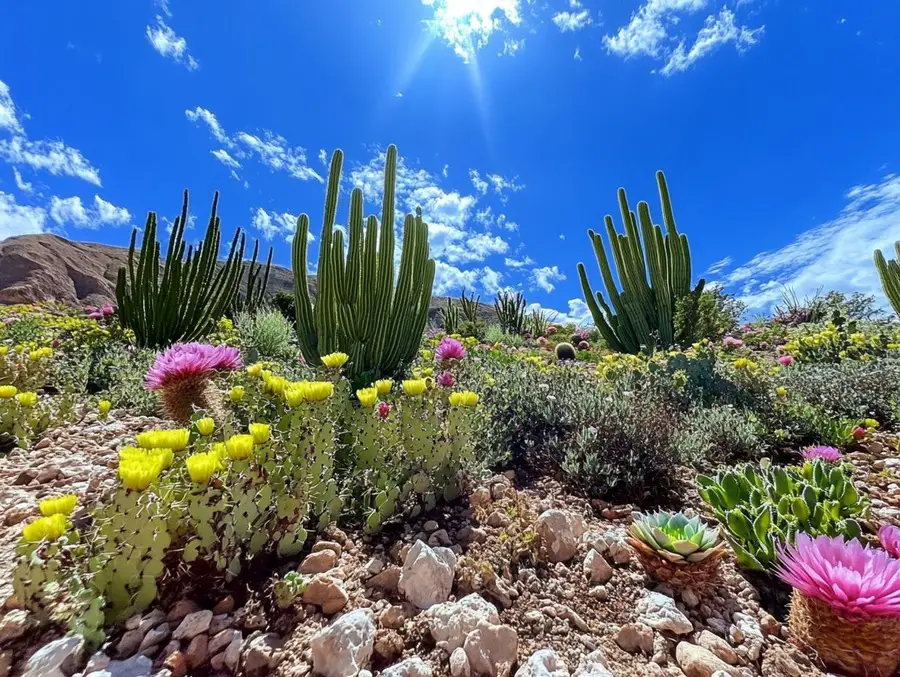
Finding the best plants for xeriscaping is key to creating a stunning, water-saving garden. Struggling with high water bills or dry soil?
With the right mix of drought-tolerant and native plants, you can design a vibrant, eco-friendly outdoor space that’s low-maintenance and bursting with life.
Let’s explore your options for a sustainable landscape!
Best Plants for Xeriscaping Key Takeaways
- The Best Plants for Xeriscaping include drought-tolerant species like lavender, yarrow, succulents, and native grasses.
- These plants thrive in dry conditions, reduce water usage, and require minimal maintenance.
- Adding trees like desert willow or mesquite enhances shade and biodiversity.
- Create a sustainable, low-maintenance landscape with these resilient plant choices.
Best Plants for Xeriscaping: Top Picks for Water-Saving Gardens
Xeriscaping is a landscaping method that prioritizes water conservation by using drought-tolerant and native plants while also creating aesthetically pleasing outdoor areas.
As weather patterns continue to become more unpredictable, it is vital for homeowners to recognize the significance of xeriscaping, incorporating sustainable gardening techniques and plant selection, in order to enhance their gardens sustainably.
Deciding Between Xeriscaping and Traditional Gardening – Xeriscaping Basics
This article delves into the advantages of xeriscaping, which include reduced water consumption, irrigation reduction, and lower maintenance expenses, as well as highlighting the best plant selections that thrive in dry conditions, such as Texas native plants and California natives.
From vibrant perennial plants to resilient succulents like Broadleaf stonecrop and Whale’s tongue agave, you will discover how to transform your landscape into a flourishing, eco-friendly oasis with seasonal blooms and colorful displays.
Key Takeaways:
- Xeriscaping is a method of landscaping that uses drought-tolerant plants to conserve water and reduce maintenance costs.
- The benefits of xeriscaping include reduced water usage, lower maintenance costs, increased property value, and promotion of biodiversity.
- When choosing plants for xeriscaping, consider the climate and soil type, look for drought-tolerant varieties, and consider plant size and growth habits.
What is Xeriscaping?
Xeriscaping is a thoughtful landscape design approach that emphasizes water conservation by incorporating drought-tolerant and native plants.
This method reduces the need for irrigation and promotes sustainable gardening practices, which is especially beneficial in areas that experience dry conditions.
By choosing xeriscape plants, gardeners can cultivate lively landscapes that flourish with minimal water, enhance biodiversity, and provide valuable support for wildlife habitats.
Why is Xeriscaping Important?
Xeriscaping holds significant importance as it plays a crucial role in water conservation, particularly in arid and drought-prone areas.
By implementing xeriscaping practices, homeowners can effectively decrease their irrigation needs, which translates to lower water bills and reduced pressure on local water resources.
Additionally, xeriscaping encourages biodiversity by incorporating native species that require less maintenance and provide support for local wildlife.
What are the Benefits of Xeriscaping?
Xeriscaping offers numerous benefits, making it an attractive option for both homeowners and landscape designers.
This landscaping approach features water-wise plants that require considerably less water.
By doing so, it conserves this vital resource and leads to reduced maintenance costs over time.
Additionally, xeriscaping plays a role in erosion control, enhances wildlife habitats, and creates a visually appealing landscape while minimizing environmental impact.
Reduces Water Usage
One of the key benefits of xeriscaping is its ability to significantly reduce water usage, which is particularly important in regions experiencing drought.
By selecting drought-resistant plants and utilizing efficient irrigation methods, xeriscaping enables homeowners to maintain vibrant gardens while conserving water, thereby promoting sustainable gardening practices.
To begin, it is crucial to recognize that the selection of appropriate plants can greatly influence water conservation efforts.
Incorporating native species ensures they thrive in local conditions and reduces the need for extensive maintenance.
Additionally, implementing efficient irrigation systems, such as drip irrigation or rainwater harvesting, can effectively deliver water to the plant roots where it is most needed.
- Soil amendments like organic mulches and moisture-retaining gels can help minimize evaporation and improve overall soil health.
- A well-thought-out layout that takes into account sun, shade, and wind patterns can further enhance water efficiency.
By integrating these strategies, anyone can cultivate a beautiful outdoor space that flourishes while conserving essential resources, ultimately benefiting the environment.
Lowers Maintenance Costs
Xeriscaping effectively reduces maintenance costs by incorporating low-maintenance plants and minimizing the need for frequent watering and chemical inputs.
This approach saves money and fosters a healthier environment through organic gardening practices.
By focusing on drought-resistant plants and employing efficient gardening techniques, homeowners can significantly decrease the resources required for upkeep.
These sustainable practices provide financial benefits and contribute to water conservation efforts.
Consider the following advantages:
- Reduced water bills due to lower irrigation requirements
- Less dependence on fertilizers and pesticides, which can add to costs
- More leisure time, as less time is needed for garden maintenance
Embracing a xeriscaping approach can lead to lower long-term expenses while simultaneously nurturing the environment, creating a scenario that benefits both one’s budget and the planet.
Increases Property Value
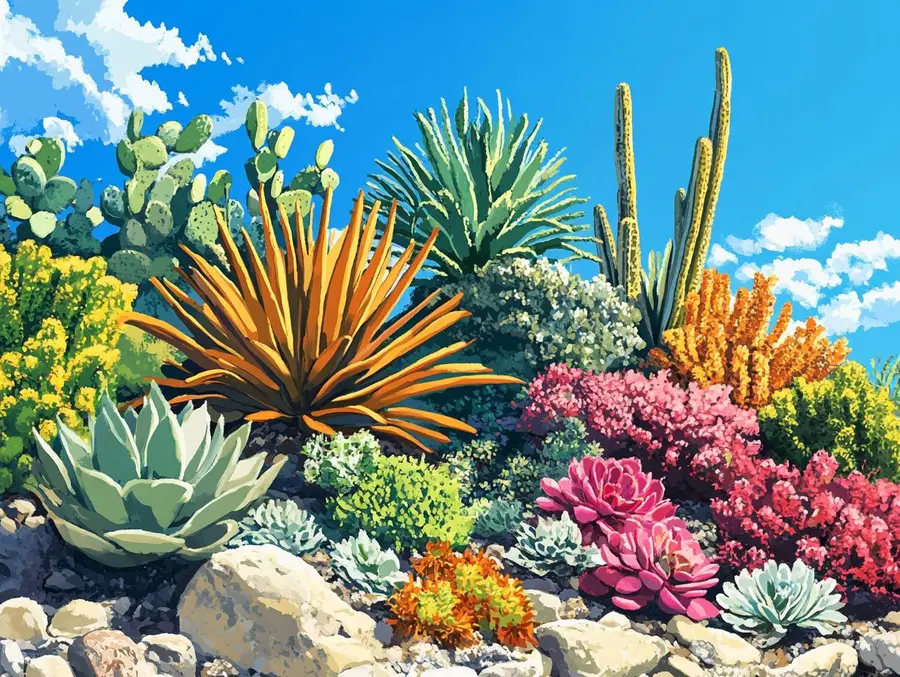
Implementing xeriscaping can significantly increase property value by enhancing the aesthetics of the landscape while promoting environmentally friendly practices.
A well-designed xeriscape can attract potential buyers who appreciate low maintenance and sustainable landscaping, making it a worthy investment.
Such thoughtfully curated spaces reduce water consumption, making them eco-conscious choices.
They also encourage the use of native species that thrive in local climates and require less maintenance, such as Carolina azalea, Germander sage, and Showy penstemon. Incorporating elements like drought-resistant plants, permeable paving, and rock gardens can elevate curb appeal, giving homes an inviting appearance.

Today’s homebuyers are increasingly drawn to properties that prioritize sustainability and environmental awareness, making xeriscaping a compelling selling point.
Many prospective buyers view these eco-friendly features as indicative of modern living. They often seek homes that help reduce their carbon footprint. Additionally, this landscaping approach can lower long-term maintenance costs, further enhancing its attractiveness.
Ultimately, embracing xeriscaping provides ecological benefits and positions a property favorably within the competitive real estate market.
Promotes Biodiversity
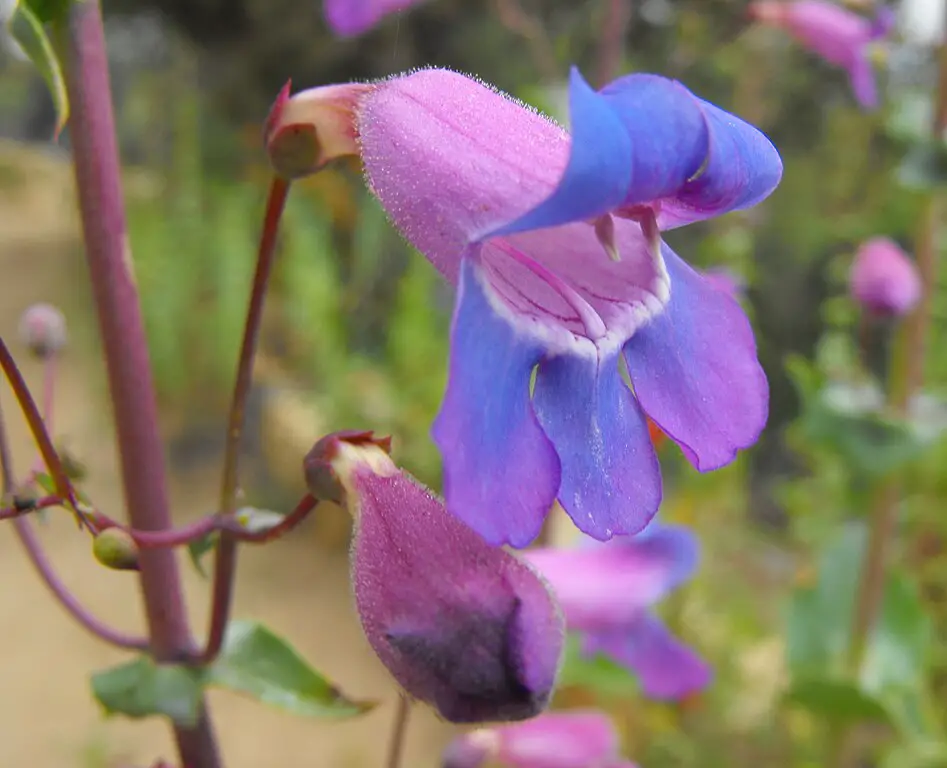
Xeriscaping fosters biodiversity by incorporating native plants that create essential habitats for local wildlife while also attracting beneficial insects and pollinators.
Additionally, this approach reduces the reliance on chemicals, which in turn supports healthier ecosystems.
This gardening technique conserves water and enhances biodiversity within the ecosystem.
When native plants flourish, they provide a nurturing environment for various species of birds, insects, and other wildlife to thrive.
These plants are well-suited to the local climate and soil, which reduces competition and promotes a balanced food chain.
Here are some key ecological advantages to consider:
- Native plants are vital in providing wildlife with food.
- Growing without harmful chemical inputs helps maintain soil health.
- Pollination of flowers by bees and butterflies enhances the sustainability of plant life.
In summary, xeriscaping beautifies outdoor spaces and plays a crucial role in creating a thriving habitat for wildlife.
What are the Best Plants for Xeriscaping?

Choosing the most suitable plants for xeriscaping requires careful consideration of drought-tolerant and native species, such as Shore juniper, Golden currant, and Common yarrow, that flourish in local conditions, all while needing low water and maintenance.
By selecting groundcover plants, perennials, and succulents, gardeners can craft stunning landscapes that display seasonal blooms to enhance the overall aesthetic appeal of their environment.
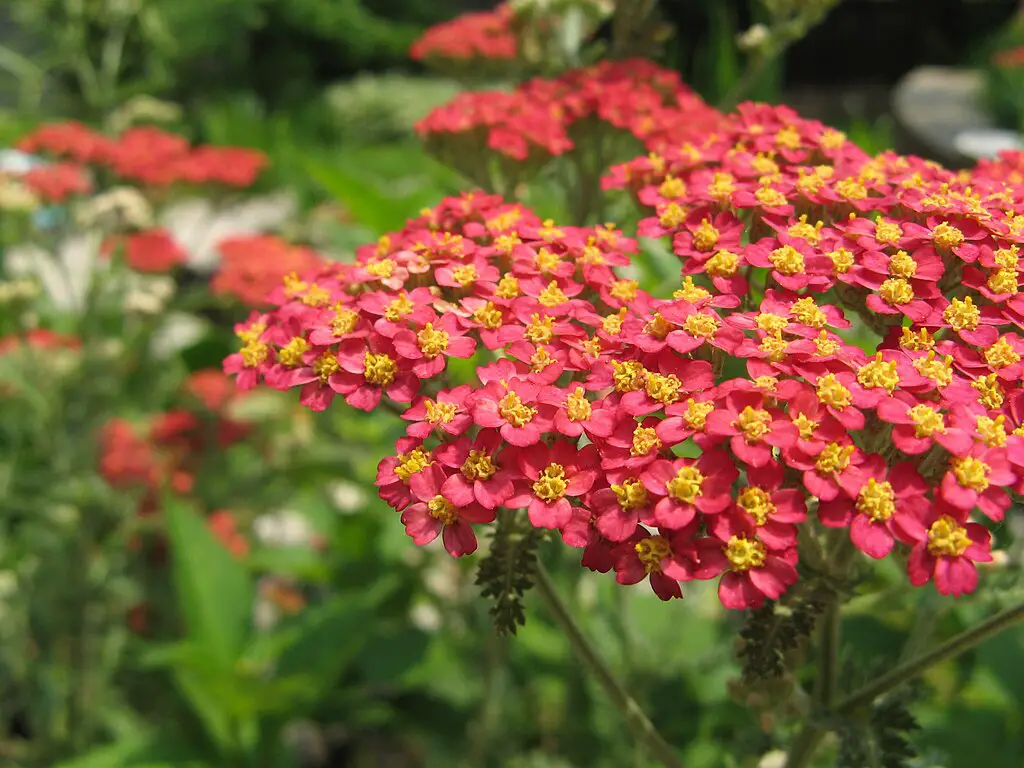
Grasses
When discussing xeriscaping, it is important to recognize that selecting the appropriate grasses can greatly enhance both the aesthetic appeal and functionality of a landscape.
Drought-tolerant grasses are particularly effective as ground cover, helping to minimize soil erosion while offering a lush appearance with low water requirements.
Therefore, choosing the right variety is essential for reaping these benefits and ensuring that the landscape thrives in harmony with its environment.
Several types of drought-tolerant grasses can significantly contribute to sustainable gardening practices. For example, Bermudagrass, Buffalograss, and Zoysiagrass are resilient and require considerably less water compared to traditional lawns.
By incorporating these varieties, gardeners can effectively address soil erosion, especially on sloped areas.
The deeper root systems of these grasses enhance soil stability, making them an ideal choice for xeriscaping.
Moreover, implementing these grasses alongside other native plants promotes biodiversity and supports local ecosystems.
This approach creates an outdoor space that is sustainable and visually appealing.
By considering environmental practices, gardeners can enhance the landscape aesthetics while ensuring minimal maintenance of gardening needs.
Perennials
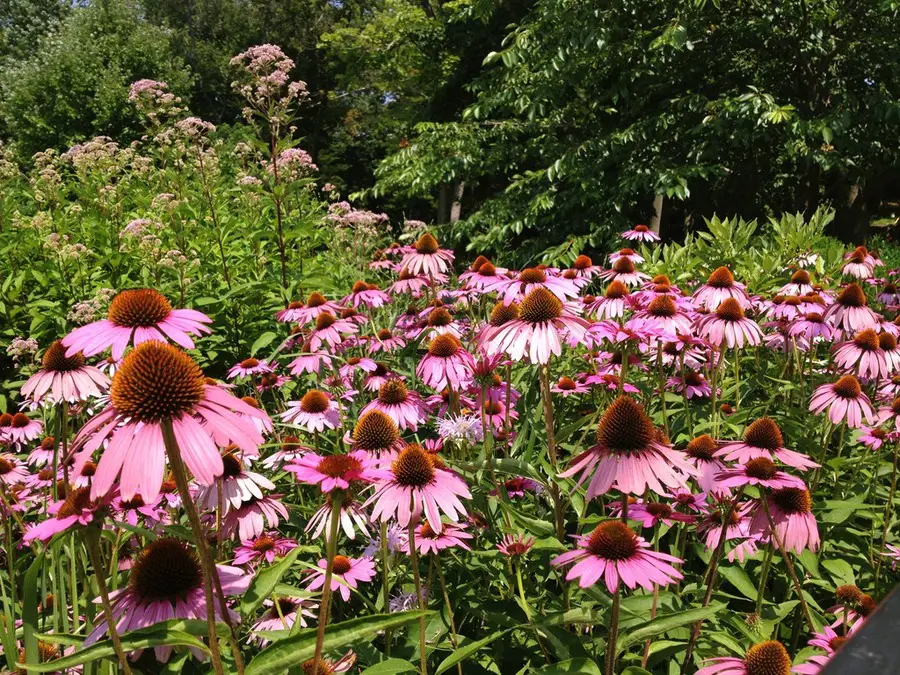
Perennial plants present an excellent choice for xeriscaping, offering a vibrant display throughout the seasons while requiring minimal water.
These resilient plants flourish in challenging environments and enhance the overall beauty and sustainability of a garden landscape.
Including flowering plants such as Purple coneflower and Bush’s coneflower can further add to the garden’s appeal.
Selecting the right resilient species is crucial when aiming to create a drought-resistant environment.
For example, lavender provides a lovely fragrance that attracts beneficial pollinators. Adding English lavender can enhance pollinator attraction.
Similarly, various sedum species display stunning colors that evolve throughout the year, and incorporating Broadleaf stonecrop can be a great choice.
Here’s a brief overview of some outstanding options for xeriscaped gardens:
- Yucca: Recognized for its striking architectural form, it produces beautiful white flowers during the summer months. Consider Spanish dagger for its dramatic impact. Yucca – Wikipedia
- Agastache: With its tall spikes of color, it adds charm to the garden and attracts butterflies. Agastache – Wikipedia
- Black-eyed Susan: A classic favorite, this perennial contributes a vibrant pop of yellow and blooms throughout the summer. Additionally, Bush’s coneflower offers similar benefits. Rudbeckia hirta – Wikipedia

By thoughtfully choosing perennial plants that can endure dry conditions, garden enthusiasts can maintain an aesthetically pleasing landscape while promoting ecological sustainability.
Succulents
.jpg_10.jpeg)
Succulents are often regarded as the cornerstone of xeriscaping due to their remarkable ability to retain water and thrive in arid conditions.
These drought-resistant plants add unique textures and colors to gardens and require minimal maintenance and care.
Incorporating species like Whale’s tongue agave and Ice plant can enhance the garden design.

How to Grow Ice Plants: The Complete Beginner’s Guide | Almanac.com
Incorporating these fascinating plants into landscape design can result in a visually striking environment that is both sustainable and easy to maintain.
One of the key advantages of using succulents is their incredible diversity; they come in a wide range of shapes, sizes, and vibrant colors, allowing for creative combinations that can suit any garden aesthetic.

For instance, succulents can serve to create eye-catching focal points, act as ground cover to prevent soil erosion and complement other drought-tolerant plants seamlessly.
Their natural ability to retain water ensures that these hardy plants can survive extended periods without rainfall, making them a practical choice for regions that experience dry spells.
Consider using Shore juniper and Largeflower tickseed to enhance the landscape aesthetics and provide additional ground cover benefits.
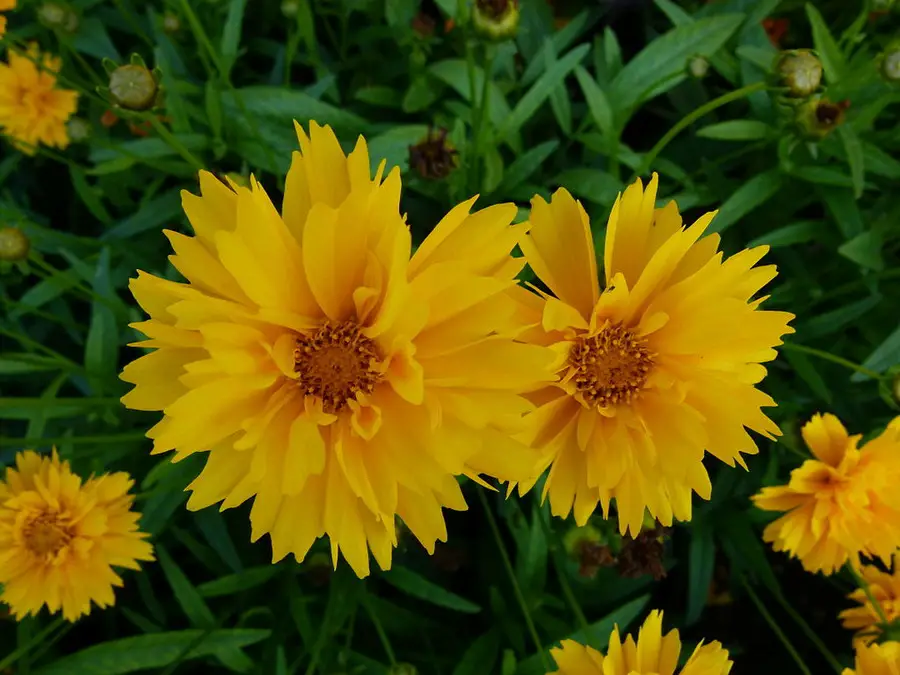
With thoughtful selection and placement, the addition of succulents can transform any outdoor space into a lush, inviting retreat that conserves water and significantly reduces gardening upkeep.
Trees
Incorporating trees into xeriscaping provides much-needed shade and plays a crucial role in supporting the overall ecosystem by benefiting local wildlife.
Choosing native tree species is essential, as they are well-suited to the local soil conditions and climate, ultimately promoting sustainability and resilience.
Shrub selection, such as Golden currant and Carolina azalea, can further support birds and insects, enhancing the vibrant ecosystem.
When selecting tree varieties for xeriscaping, it is important to focus on those that thrive with minimal irrigation. Some excellent options include:
- The Palo Verde tree provides shade and attracts pollinators to your landscape; additionally, the tree’s insect attraction properties support the local ecosystem. Parkinsonia florida – Wikipedia
- The Mesquite tree is another fantastic choice, as it offers a habitat for birds and other fauna while requiring very little water. Incorporating Big sagebrush around it can further support the habitat. Mesquite – Wikipedia

- The Desert Willow enhances the aesthetic appeal of your outdoor space with its striking blooms, which also support local bee populations. Consider adding Showy penstemon to complement its blooms. Chilopsis – Wikipedia
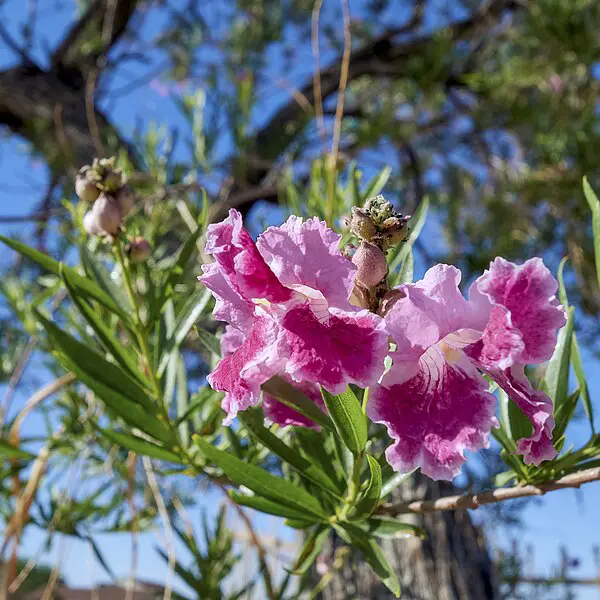
By prioritizing these tree species, individuals can create a vibrant ecosystem that fosters biodiversity while conserving valuable water resources.
Incorporating these native species into outdoor environments beautifies the area and promotes a balanced habitat, ensuring the well-being of local wildlife. Incorporating evergreen foliage plants like Chinese juniper can add year-round structure to the garden.
How to Choose the Right Plants for Xeriscaping?
Selecting the appropriate plants for xeriscaping requires a thorough understanding of your local climate and soil type, which is essential for promoting optimal growth and sustainability.
Understanding the USDA hardiness zones can further help you make informed selections for your garden.
By taking into account factors such as sunlight requirements, soil preferences, and the unique traits of drought-tolerant varieties, gardeners can successfully design a flourishing xeriscape that demands minimal water and maintenance.
Consider Climate and Soil Type
When selecting plants for xeriscaping, it is important to consider the local climate and soil type.
Choosing plants that are well-suited to the specific environmental conditions will allow them to thrive with minimal care, ultimately supporting successful xeriscaping efforts.
Additionally, recognizing the sun requirements of each plant will help in their placement within the garden.
Understanding the unique characteristics of the local environment is essential for making informed decisions regarding plant selection in a xeriscape design.
Many homeowners may not be aware that variations in local climate, such as temperature extremes and precipitation patterns, play a significant role in plant survival.
The soil’s texture and composition can greatly affect how well certain species adapt and flourish.
For instance, healthy soil enriched with organic matter can improve plant resilience and growth.
- For example, sandy soils may necessitate plants with deep root systems, while clay soils require varieties that can tolerate moisture retention. Adding Common yarrow and Berlandier’s sundrops can be beneficial in such conditions.
- By prioritizing plants native to the region, one can enhance adaptability and resilience, ensuring they can withstand drought and other environmental stresses. Consider Xeriscaping with local varieties for best results.
- Incorporating a diverse range of plant types can contribute to a balanced ecosystem that thrives with minimal input. Using shrubs like Germander sage and Golden currant adds diversity.
Ultimately, taking the time to understand these factors will lead to a sustainable xeriscaping solution that benefits both the landscape and the environment.
Including hardscape materials like gravel and stones can reduce water needs while maintaining garden aesthetics.
Look for Drought-Tolerant Varieties
When selecting plants for xeriscaping, it is important to prioritize drought-tolerant varieties that are specifically designed to thrive in low-water conditions.
These plants reduce the need for irrigation and simplify maintenance gardening practices.
For example, selecting plants known for their low maintenance needs, such as ice plants and Showy penstemon, can significantly reduce gardening upkeep.
Gaining an understanding of the unique characteristics of these resilient plants can greatly enhance your gardening success.
For example, many drought-tolerant species have developed mechanisms that enable them to store water, making them particularly suitable for arid climates.
The water needs of these plants are minimal, making them ideal for xeriscaping.
Choosing such varieties contributes to sustainable gardening practices and fosters an ecosystem that supports local wildlife.
You might consider exploring options such as:
- Succulents, which retain moisture within their leaves. Consider Whale’s tongue agave for a striking presence.
- Perennials like Russian sage that thrive on minimal rainfall. Adding Common yarrow and Golden currant can enhance the perennial selection.
- Ornamental grasses known for their hardiness and low maintenance needs. Shore juniper and Ice plant can be excellent ground cover choices.
By incorporating these plants into your landscape, you will create a vibrant and eco-friendly garden that showcases both beauty and resilience while minimizing environmental impact.
Consider Plant Size and Growth Habits
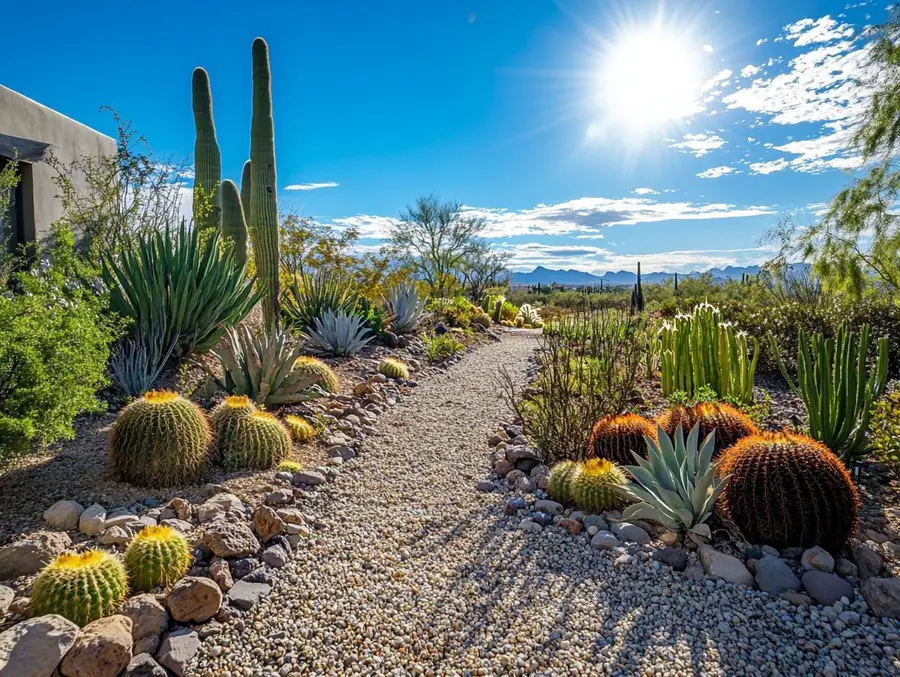
Considering the size and growth habits of plants is essential when designing a xeriscape, as it directly impacts both the overall aesthetics of the garden and its ecological balance.
Understanding how plants will mature helps in creating a visually appealing and sustainable landscape.
When incorporating a variety of plants into the design, it is important for gardeners to assess their current size to anticipate their full growth potential.
This foresight ensures that plants do not overcrowd one another, which could lead to competition for vital resources such as water and nutrients.
Selecting appropriate shrub species and considering shrub selection like Carolina azalea and Germander sage can prevent overcrowding.
By allowing for appropriate spacing, one can promote a healthier ecosystem within the garden.
Growth habits are also key, as they inform us about seasonal changes in appearance, enabling a design that remains engaging throughout the year.
Ultimately, careful consideration of plant dimensions significantly influences overall maintenance strategies.
A well-planned xeriscape can minimize the need for frequent pruning and other interventions, making it visually appealing and easier to maintain.
Incorporating low maintenance plants like Big sagebrush and Golden currant can help achieve this goal.
What Are Some Examples of Xeriscaping Designs?
Numerous examples of xeriscaping designs illustrate the beauty and functionality of this sustainable landscaping approach.
Incorporating hardscape materials like gravel and stones can enhance the garden’s aesthetic.
For instance, Mediterranean gardens often incorporate drought-tolerant plants, while Desert Oasis designs prominently feature succulents and cacti.
These diverse styles effectively showcase the versatility of xeriscaping across various environments.
Other examples like Texas native plants and California natives can further enhance your garden design.
Mediterranean Garden

A Mediterranean garden is an increasingly favored xeriscaping design that prioritizes drought-tolerant and native plants.
This style effectively captures the essence of coastal climates and employs a range of textures and colors to create a visually appealing landscape.
Incorporating plants with evergreen foliage like Shore juniper can provide year-round interest.
In these gardens, one can frequently encounter plants such as lavender, rosemary, and succulents.
These selections are made for their resilience, aromatic qualities, and ornamental beauty. Adding English lavender and Ice plant can further enhance these qualities.
The design typically features elements like ornamental stones, terracotta pots, and gravel paths, which help to direct the eye and enhance the overall aesthetic.
Integrating native flora into the garden offers numerous advantages, including reduced water requirements and increased biodiversity.
A Mediterranean garden transcends mere plant collections. It provides an immersive experience that encourages visitors to appreciate the beauty of low-maintenance greenery, such as Shore juniper and Germander sage, while embracing sustainable practices.
Key features include:
- Drought-resilient plants
- Varied textures and colors
- Natural pathways to explore
Desert Oasis

The Desert Oasis design exemplifies the principles of xeriscaping, featuring an impressive array of succulents such as Broadleaf stonecrop and Ice plant, and low-water plants that create a vibrant, water-efficient landscape.
This design often integrates hardscape materials to enhance visual appeal while minimizing water consumption.
At the center of this innovative design, one may encounter a remarkable selection of drought-tolerant plants that flourish in arid conditions. Here are a few highlights:
- Cacti and Whale’s tongue agave, with their distinctive shapes and resilience, serve as captivating focal points.
- Agaves, such as Whale’s tongue agave, and yuccas like Spanish dagger, contribute texture and sharp linear contrasts, adding visual depth to the space.
- Colorful flowering plants, such as desert marigold, blanket flower, and Bush’s coneflower, introduce life and vibrant splashes of color, attracting beneficial pollinators.
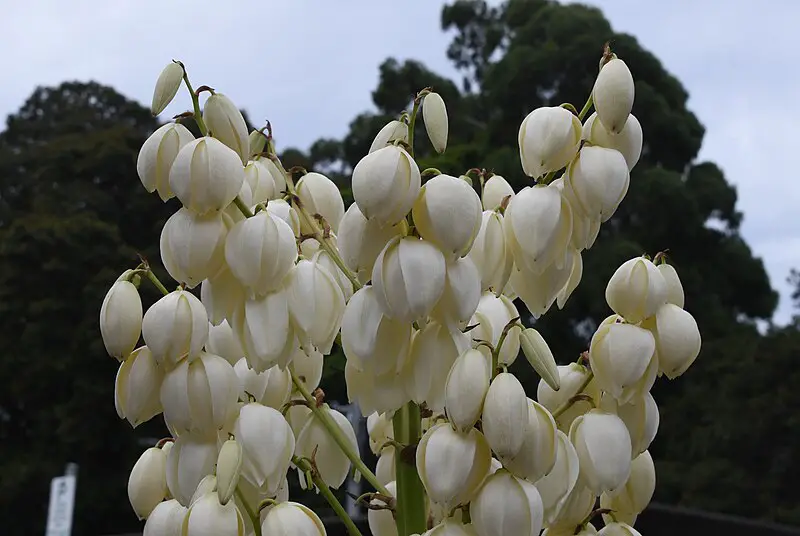
Hardscape features like gravel paths, decorative boulders, and permeable pavers complement these plants promote efficient drainage, reducing the need for excessive irrigation.
When these elements are thoughtfully combined, including USDA hardiness considerations, they create a sustainable oasis that harmonizes beauty with a respect for natural resources.
Native Prairie
A Native Prairie design for xeriscaping embraces local ecosystems by incorporating a diverse array of native species, including Big sagebrush and Golden currant, that promote biodiversity while requiring minimal water.
This thoughtful design supports wildlife habitats enhances the natural beauty of the landscape.
Including these native plants in xeriscaping serves to conserve water and plays a crucial role in restoring the organic balance within their environment.
By choosing locally adapted flora, gardeners can significantly reduce their reliance on chemical fertilizers and pesticides, which leads to healthier ecosystems.
This approach offers numerous ecological benefits, including:
- Improved soil health through increased microbial activity and chemical reduction.
- A supporting role in pollinator populations, attracting vital species such as bees, butterflies, and native plants like Showy penstemon.
- Minimized erosion by establishing deep-root systems.
Ultimately, these practices contribute to a more sustainable gardening approach, allowing individuals to enjoy a vibrant landscape that thrives reinforces the ecological integrity of the region.
Modern Minimalism
Modern minimalism in xeriscaping is centered around clean lines, simple forms, and a selective plant palette, featuring plants like Carolina azalea and Chinese juniper, all of which contribute to a serene and low-maintenance landscape.
This design philosophy emphasizes sustainability achieves an elegant aesthetic.
This approach enhances visual appeal and creates an environment that is easy to maintain, ultimately saving both time and resources.
Garden enthusiasts and homeowners alike discover that by opting for native plants and drought-resistant species like Common yarrow and English lavender, they can cultivate vibrant spaces that thrive with minimal irrigation.
Incorporating decorative gravel, minimalist pathways, and strategically placed hardscaping elements such as Largeflower tickseed and Berlandier’s sundrops adds to the overall charm while effectively managing water use.
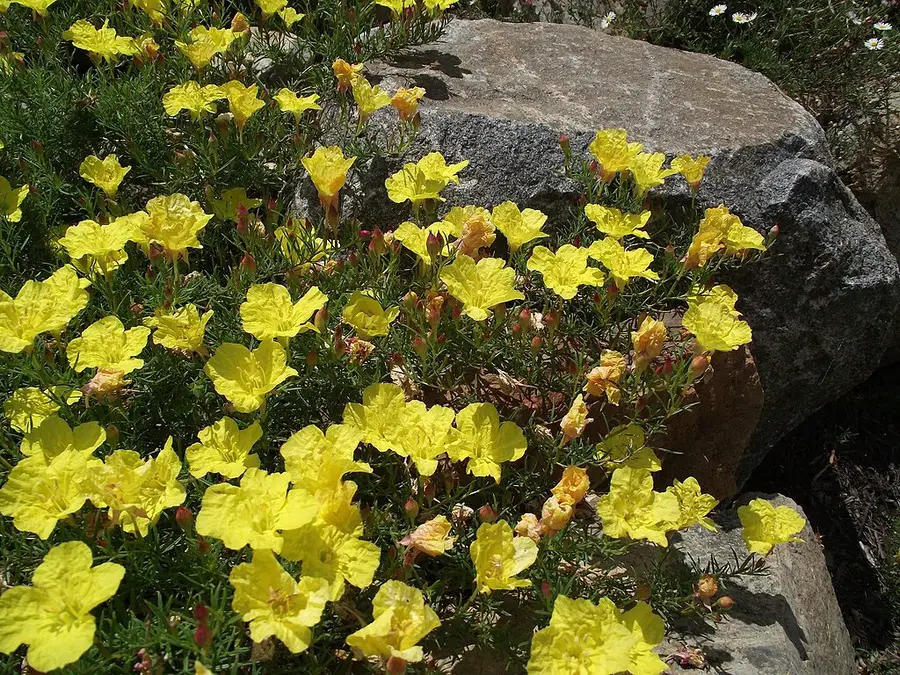
As these principles are put into practice, the outcome is not merely a garden but a harmonious outdoor retreat that reflects personal style and a commitment to ecological responsibility.
- Utilizes drought-tolerant plants
- Focuses on efficient water usage
- Reduces yard waste by minimizing maintenance
Best Xeriscape Plants by Regions
Drought Tolerant Plants for Arizona: Amazing Low-Water Ideas
Best Utah Xeriscape Plants: Low-Maintenance Water-Wise Picks for Your Yard
Top Drought Tolerant Plants for Colorado: Stunning Picks for Dry Gardens
Drought Tolerant Plants for California Xeriscaping: 22 Amazing Picks
Best Plants for Xeriscaping FAQs
What are the best plants for xeriscaping?
The best plants for xeriscaping include grasses, perennials like Purple coneflower, succulents, and trees that are drought-tolerant and require minimal water.
What are some drought-tolerant grasses for xeriscaping?
Some of the best drought-tolerant grasses for xeriscaping include blue grama, buffalograss, and purple needlegrass.
Which perennials are suitable for xeriscaping?
Perennials such as yarrow, lavender, and coneflower are great options for xeriscaping as they can withstand dry conditions and still thrive.
Can succulents be used in xeriscaping?
Yes, succulents are excellent plants for xeriscaping as they have the ability to store water in their leaves and stems, making them highly drought-tolerant.
Are there any trees that are suitable for xeriscaping?
Yes, some trees that are suitable for xeriscaping include mesquite, palo verde, and desert willow, as they are adapted to survive in dry climates.
Do all xeriscaping plants need full sun?
No, not all xeriscaping plants require full sun. Some, like shade-loving perennials, can thrive in partly shady areas of the landscape.
Read more:
An Introduction to Xeriscaping: Water-Saving Garden Ideas – Xeriscaping Basics
Benefits of Xeriscaping: Save Water, Time, and Money – Xeriscaping Basics
Xeriscaping Design Principles: Beautiful Yards, Less Water – Xeriscaping Basics
Xeriscaping for Beginners: Easy Water-Saving Yard Tips – Xeriscaping Basics
